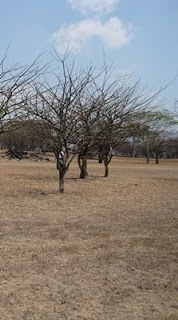The Morro Tree
 Cihuatán is an archeological site which lies just north of Aguilares. Amidst the Mayan ruins, which are definitely worth seeing, you will also find some of the local flora and fauna of the area. This area north of Guazapa has become cattle country, and, according to the locals, some of the wealthy cattle producers have their eye on this property. The security guards and barbed wire fences do a pretty good job of keeping cows off of the site, but nothing can keep the goats from enjoying a good run in the field. The wide variety of bird calls, the tinkling of the goat bells, and the low moos in the distance create a peaceful atmosphere in which to enjoy the ruins and have a relaxing, yet very hot, walk with friends.
Cihuatán is an archeological site which lies just north of Aguilares. Amidst the Mayan ruins, which are definitely worth seeing, you will also find some of the local flora and fauna of the area. This area north of Guazapa has become cattle country, and, according to the locals, some of the wealthy cattle producers have their eye on this property. The security guards and barbed wire fences do a pretty good job of keeping cows off of the site, but nothing can keep the goats from enjoying a good run in the field. The wide variety of bird calls, the tinkling of the goat bells, and the low moos in the distance create a peaceful atmosphere in which to enjoy the ruins and have a relaxing, yet very hot, walk with friends.Surrounding the large hill which was constructed to support the main temple, there is a broad, grassy field, dotted with trees. Pablo, our driver and friend, said that during the war, there was a lot of looting of this site. People drove big trucks in to take the rocks and cut down the trees for wood. Some of the trees which we see now may have grown from seeds or stumps. He thinks that most of them were planted as part of the restoration.
 One tree that caught my attention was the morro tree.
One tree that caught my attention was the morro tree.For a long time, all I knew about the morro tree was that it made some kind of fruit with a really hard shell. I have a morro shell among my Salvadoran treasures. It was a gift from my friend, Ana Julia. When Julia was little, her family used morro cups and bowls to hold their beverages and soups. Julia had 3 morro cups in her cabinet, and she gave two of them away ... one to me. Whenever I pick up the little morro cup, so light yet so durable, I think about Julia. She is a good teacher, and a good friend, and also, in sort of a sad way, durable.
The strange thing about the morro fruit is that it is connected directly to the trunk and big branches of the tree. The tree looks pretty comical in the dry season, with no leaves and the big green fruits stuck to the trunk. Pablo said that the seeds are used to make horchata. Seriously? You would think that after all of my visits to El Salvador that I would know that Salvadoran horchata is made from morro seeds. You open the fruit, take out the seeds, dry them, grind them up, mix with water, maybe add a pinch of cacao or cinnamon, (although out in the countryside, it is pretty common not to add anything) and you have horchata. What do you do with the fruit itself? Feed it to the cows. Apparently it makes good animal food but not very good people food.
I always wonder about those who first came up with the idea to hack open some weird gourd fruit, save and dry the seeds to make a drink powder, and then taste it. "Hey, it's good!" or "Great, he didn't die!" Let's make it a traditional drink!
Pablo said that he went to one church where they had gigantic morro cups which they used to serve their shuco. Shuco? ... another Salvadoran traditional drink, eaten as a meal, and a story for another day.



Wow! Great information.... Love your stories, Linda. They make me feel as if I were there with you. :-)
ReplyDeleteThe morro seeds are what make El Salvador so unique :) in terms of horchata
ReplyDeleteHave you ever happened to meet any indigenous people?
I am from El Salvador but have yet never met anyone who's of indigenous ancestry
Hi Yanel,
ReplyDeleteI have not met anyone who has identified himself or herself as having 100% indigenous ancestry. I do have many friends who have some indigenous roots and have preserved traditions (especially the women)from long ago.
Thanks for your comment.
Linda
Hi Linda!
ReplyDeleteI love your blog! I found you while searching for information about the morro tree. My husband is from El Salvador originally and I have a blog about Salvadoran desserts. Would you mind if I added a link to your posting on my page about the morro seed? Here's my posting link:
http://www.postresdelacipota.com/2011/08/morro-seed.html
Thanks and God bless you for all your work down there!
This is just the information I am finding everywhere.Me and my friend were arguing about an issue similar to this! Now I know that I was right.Thanks for the information you post. I just subscribe your blog. This is a nice blog.
ReplyDeleteHealth + write for us